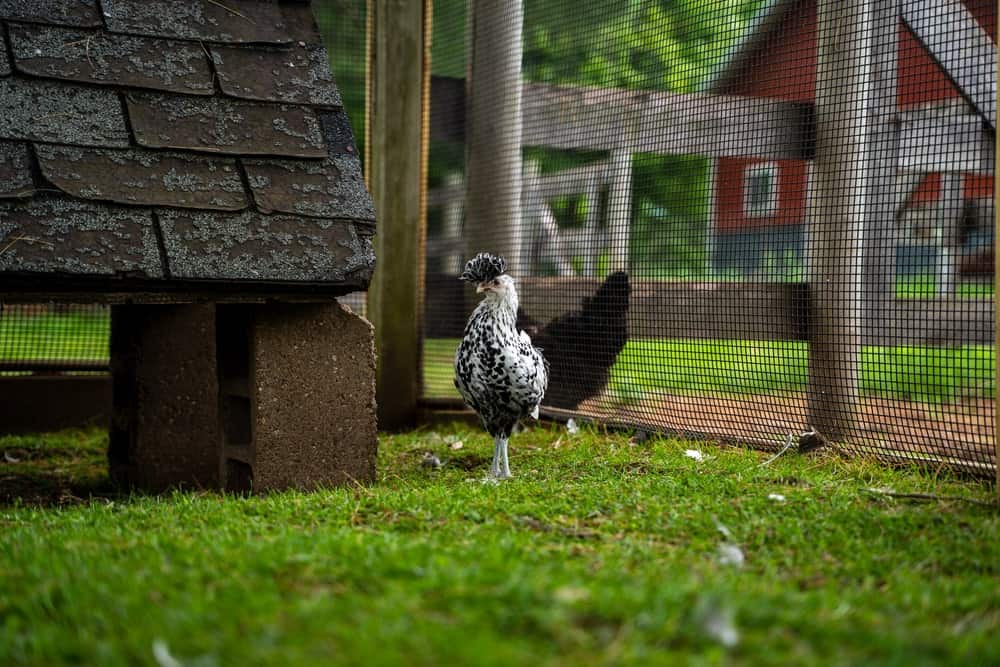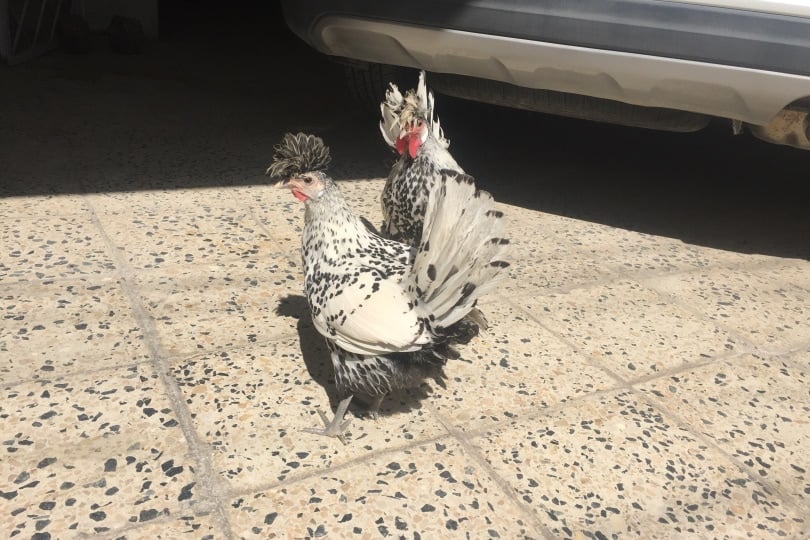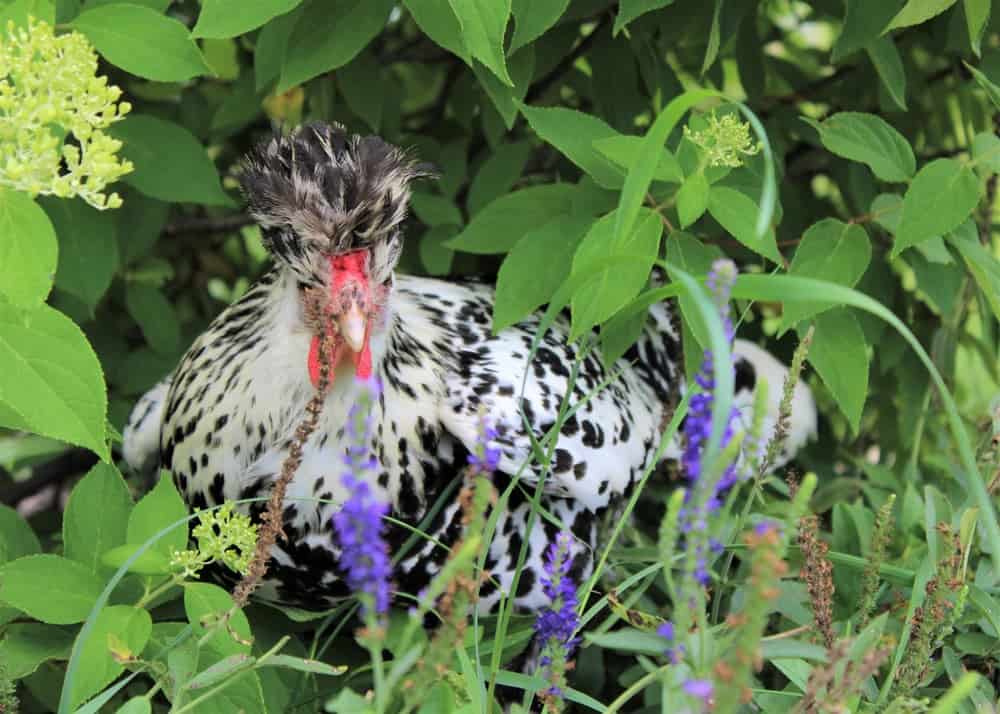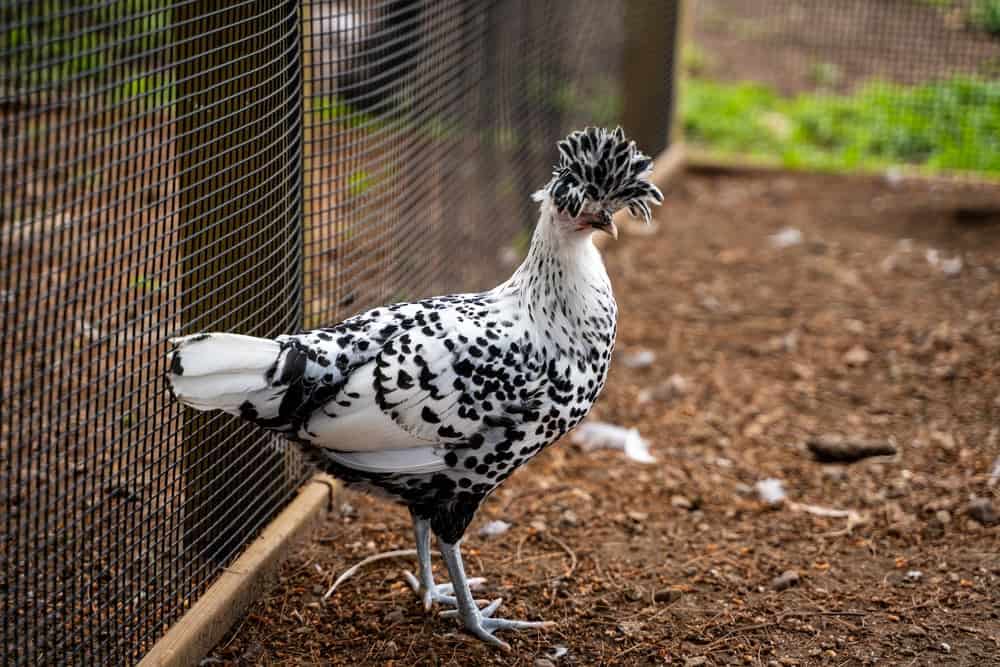Although it’s unforgettable in appearance and an absolute champion at egg-laying, the Spitzhauben Chicken is not a common breed in the United States, but its potential is limitless, especially for small-scale farmers. This article will cover vital information about the breed, traits, and a care guide for the Swiss chickens. We’ll also discuss how the birds can add value to your hobby farm.

Quick Facts about Spitzhauben Chicken
| Breed Name: | Appenzeller Spitzhauben |
| Place of Origin: | Switzerland |
| Uses: | Egg production |
| Rooster (Male) Size: | 4.5 pounds |
| Hen (Female) Size: | 3.5 pounds |
| Color: | Silver spangled (most common), gold, black, blue, or chamois spangled |
| Lifespan: | 5–8 years |
| Climate Tolerance: | All climates |
| Care Level: | Easy |
| Production: | ~ 3 eggs/week, 150-180 eggs/year |
| Optional: | Not yet recognized by the American Poultry Association |
Spitzhauben Chicken Origins
The Spitzhauben originated from Switzerland, where it is the national bird. It was first developed by monks in the 1500s and wasn’t found outside Switzerland until the late 1800s, but it remained rare even then.
Unfortunately, the breed was nearly eliminated after World War II but was largely saved through the efforts of a German farmer who brought the Spitzhauben to Germany in the 1950s. From there, the breed spread throughout Europe. The first Spitzhauben chicks were also exported to the United States during this time.

Spitzhauben Chicken Characteristics
The Spitzhauben is an active, often flighty bird that doesn’t tolerate confinement well. The breed needs space to roam and forage to reach its full potential. Spitzhauben that are confined to a small enclosure may become aggressive and moody. The chickens are excellent climbers and often roost in trees. Because of this, they need a secured area to roam, ideally with a tall fence or cover to prevent escape and protect them from predators.
The Spitzhauben is a relatively friendly bird, but it’s not necessarily as calm and gentle as other breeds. They are usually quiet and get along with other chickens unless they don’t have enough space to move around. Spitzhaubens love to forage and are usually inexpensive to raise because they are experts at scavenging for meals. They are generally healthy birds, but some U.S.-bred birds suffer ailments related to inbreeding.
The Spitzhauben is a superb egg layer, especially for its smaller size. The only thing that decreases their production is the molting season, but they lay reliably all year-round, even in cold weather. The eggs are medium-sized and white. As you might expect from a bird bred in a mountainous, Alpine country, the Spitzhauben tolerates cold weather. They’re surprisingly tolerant of heat also, making them an excellent choice for most climates.

Uses
The Spitzhauben was bred as an egg-laying bird, and it typically produces 150-180 eggs per year. In Europe and the U.K, Spitzhauben are raised as show chickens due to their striking and beautiful appearance. Because they lay so many eggs, hatching Spitzhauben chicks to sell is another potential use of the breed.
Appearance & Varieties
The most distinctive features of the Spitzhauben are its colors and upright crest. They are small birds with rounded bodies. Their combs are V-shaped, and the crest stands up and slightly forward on their heads.
The birds have blue legs and a bluish tint to their beaks. The most common color pattern, especially in the United States, is silver spangled. This color features white feathers with black edging, explaining why the Spitzhauben is sometimes described as a “Dalmatian with a mohawk.”
Other possible color patterns include gold, black, blue, and chamois spangled. The birds also have white skin. While the U.K. and several European countries maintain a show standard for the Spitzhauben as a recognized breed, no such registry exists in the United States.
Spitzhaubens in the United States often have inconsistencies in their appearance due to crossing with other breeds. Until the American Poultry Association recognizes the breed, buyers should be cautious and ensure they are purchasing actual Spitzhauben birds.
Population
As we mentioned, the Spitzhauben nearly went extinct after World War II, and the breed’s numbers are still recovering. In fact, the bird is considered threatened due to their low global population. Most Spitzhauben chickens are found in Europe and the U.K. They remain relatively hard to find in the United States, although they are gaining popularity. Many U.S. breeders import birds from Europe to improve the overall quality of the Spitzhauben in America.

Are Spitzhauben Chickens Good for Small-Scale Farming?
Spitzhaubens are suitable for a small-scale farm because they are inexpensive to feed and produce a high egg yield. With each bird laying around three eggs per week, there are more than enough to sell for profit. Because they prefer to be raised free-range, Spitzhaubens are a better option for a small farm with plenty of open space. However, they’re not easy to find in the United States.

Conclusion
If you’re considering raising chickens for eggs, the Spitzhauben is an excellent option. However, you need enough space for the birds to stretch their free-range muscles. Before purchasing new chickens, double-check the local rules and regulations concerning poultry and livestock. It’s also not a bad idea to let your neighbors know about your new venture. Hopefully, the promise of fresh eggs to share will make the idea of Spitzhaubens living next door a bit more appealing!
Featured Image Credit: Bullet Point Ranch, Shutterstock
